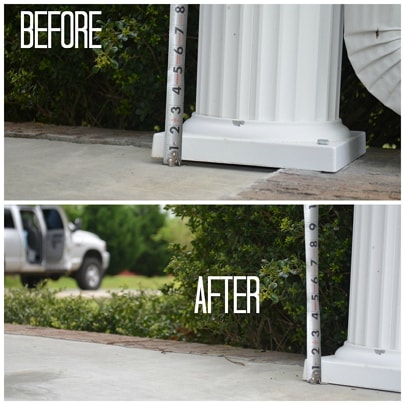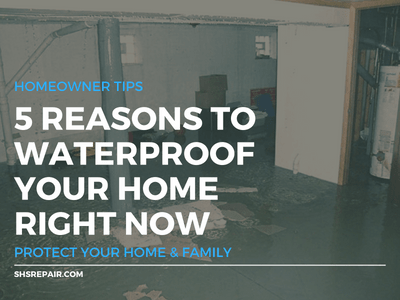 Concrete slab issues can be concerning for homeowners. No one wants to find that their slab has settled or cracked.
Concrete slab issues can be concerning for homeowners. No one wants to find that their slab has settled or cracked.
Not only are these problems unsightly and often the culprit for home accidents like trips and falls, but they are also often the sign of slab or foundation failure. Cracks and settlement indicate slab movement, which can lead to a range of different problems like leakage and water pooling, concrete deterioration, and interior issues in the case of slab foundations.
So what is the best way to get your slab back to its original condition?
If the problem looks bad, many homeowners think that their only option is total concrete replacement. However, there is another option that can save you money, time, and headache. Southeastern Home Solutions offers Poly Raise solutions to lift and level concrete and to prevent further problems from occurring. This method, an alternative to the more traditional mudjacking, process, utilizes an expansive polyurethane foam that is injected under the slab to fill voids and raise concrete. This solution not only raises and levels slabs, it also stabilizes the soil underneath to prevent future problems.
LEARN MORE: All about concrete leveling with Poly Raise.
Replacing your concrete slab is one way to fix concrete problems like cracks and settlement or heaving. However, this option will cost you, and it is usually a rather lengthy process. In addition, concrete replacement tends to be a much more complicated and invasive procedure than concrete leveling.
First, let’s examine the cost difference between concrete leveling with Poly Raise and According to Home Advisor, the average cost of building a foundation or basement in the US ranges from about $4000-$13,000 with the high-end costs even reaching $25,000 (source). New concrete patios cost anywhere from $1500-$6000 (source), while driveways typically cost somewhere from $1800-$6000 (source). However, concrete leveling costs usually range from $515-$1200 (source), putting the overall average much lower than new concrete replacement. That means you can save some cash and put it toward things you love instead.
In addition to being a more affordable option than concrete replacement, our Poly Raise mudjacking-alternative saves time. Once the polyurethane foam is injected through holes we drill in the slab, it cures in about 15 minutes. Once the holes are patched and set, the slab is ready for normal use again. This process typically takes a day or less, while concrete replacement can take several days, especially when you factor in the removal of the old concrete and curing time for the new concrete.
Yet another benefit is that concrete leveling with Poly Raise will not affect your home or property nearly as much as concrete slab replacement. Tearing out and pouring new concrete requires a lot of equipment and can impact landscaping and the general area around your slab. Poly Raise requires very little equipment and is a relatively non-invasive process. We’ll have the job finished and the site cleaned up in no time, causing little to no disturbance to you.
These are just a few of the reasons that our concrete leveling method is a better choice than completely replacing your concrete slab. Whether you have a driveway, patio, slab foundation, garage, parking lot, floor or pool deck that you need leveled, call Southeastern Home Solutions today to take a look. We serve the areas around Nashville and Chattanooga, TN and Huntsville and Birmingham, AL as well as other places. Take a look at our full service area and give us a call today.
 With rain on the forecast for the rest of the week throughout Alabama, Tennessee, and Georgia, it’s important to start thinking about the damage that all of this water could do to your home and foundation. Excessive rain can saturate the soil, causing water to pool around your home and seep inside. Not only does this cause wet basements and flooding, but it can also result in deterioration and other foundation problems.
With rain on the forecast for the rest of the week throughout Alabama, Tennessee, and Georgia, it’s important to start thinking about the damage that all of this water could do to your home and foundation. Excessive rain can saturate the soil, causing water to pool around your home and seep inside. Not only does this cause wet basements and flooding, but it can also result in deterioration and other foundation problems.
Learn more about wet basements this Spring: APRIL SHOWERS BRING…WET BASEMENTS
Learn more about what causes foundation damage: CAUSES OF FOUNDATION PROBLEMS
Read on to find out why you should waterproof your home and basement to prevent these issues and how Southeastern Home Solutions can help.
A home that does not have adequate basement and foundation waterproofing runs the risk of letting water seep inside. Water normally enters your basement and home through cracks in the foundation, although it can also seep through the porous concrete of the foundation walls. Installing proper drainage systems, ensuring that downspouts work properly, and manipulating the slope of the lawn so that water does not pool by the home are all important steps in reducing basement moisture and flooding. Sum pump systems in the home also prevent flooding by removing and rerouting any excess water that makes its way into the basement.
If any water makes its way into your basement, even if it is a small amount, it can cause high humidity in the area. This high humidity can affect the air throughout your home, since the air in your basement cycles through the rest of the home. High moisture levels in the air can also affect respiratory conditions and cause the home to feel warmer during the summer months, meaning you might spend more on air conditioning. To reduce moisture, make sure any cracks in your foundation are properly closed and sealed and invest in interior waterproofing. De-humidifiers from Santa Fe can also help reduce excess moisture and humidity in your basement.
Several foundation problems can result from water seepage. If water starts collecting in puddles against your home, it can start to eat away at the concrete foundation or seep through the porous materials, causing the concrete to weaken. This puts the structural stability of your home at risk. In addition, a lack of proper drainage around your basement and foundation can result in high hydrostatic pressure when the soil gets saturated. This pressure pushes on the foundation and can cause shifting and crack formation. Be sure to install adequate drainage and fill in any low spots near the hoe where water might collect to prevent these issues.
Flooding and damp basements present a range of different issues. One of these issues is that the water that enters your home might ruin your personal property. All kinds of personal items, such as electronics, upholstered furniture, paper documents, and more can be ruined by basement flooding and dampness. Water seepage in your basement can also cause wood rot, metal rust, and can cause insulation in the walls to become soaked musty. Proper drainage systems and a sump pump system alleviate these problems by keeping water out of your home.
High moisture levels in your basement can provide the perfect environment for mold and mildew growth. Mold and mildew commonly grow in areas you may not be able to see or access easily when moisture seeps into your basement. Be aware of any musty odors or any worsened respiratory issue or allergy symptoms among residents of your home. Get any visible mold removed as soon as possible and follow with waterproofing and dehumidification to prevent future mold growth.
Keep your home and family safe with basement waterproofing from SHS. Call us for a free quote today to combat the spring rains.